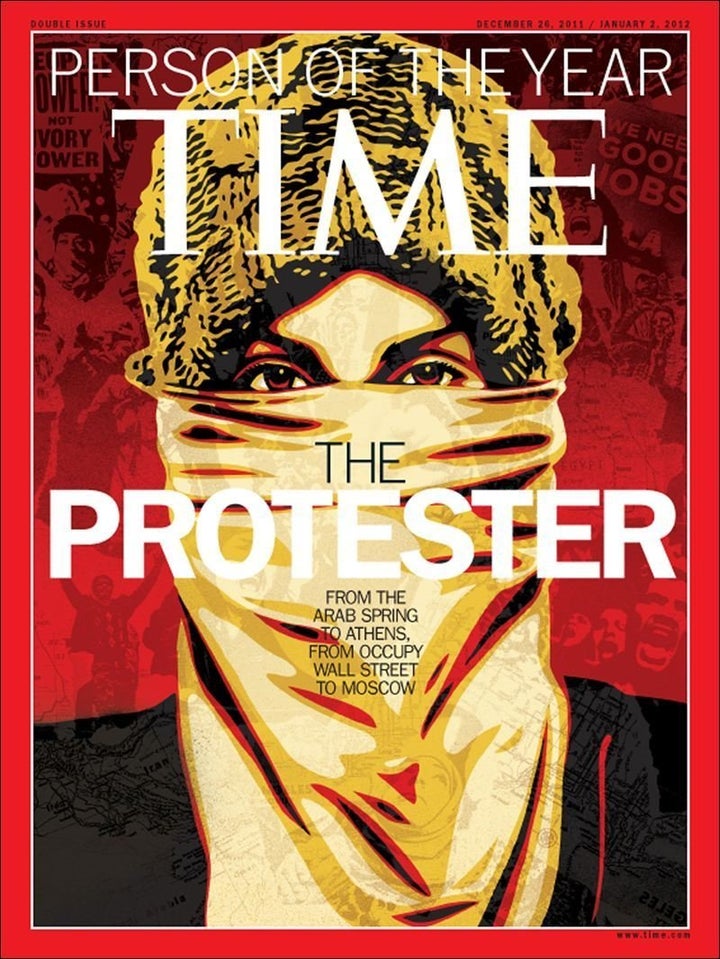
From the very start of the Arab Spring popular revolts one year ago, there has been a consistent urge to put a face on the phenomenon--to reduce it down to a something tangible and human-sized. It's a natural impulse, part human nature and part driven by a media culture that needs individuals to quote, profile and put on magazine covers.
The willingness to resist that urge is part of what makes Time Magazine's choice of "The Protester" as 2011's Person of the Year so appropriate. I'm sure there was an in-house debate at some point over whether to choose someone like Wael Ghonim or Ahmed Maher of the April 6 Movement. But that route would have been not only divisive but an insult to the true nature of these phenomena.
I covered the Egyptian revolution from the beginning, as well as the crucial final years that preceded it. Along the way, I lost track of just how many times I wrote or spoke the word "leaderless" in an article or interview. But there was no other way to describe what was happening.
From the first shockingly large public protests on January 25, it was like some sort of highly disciplined hive-mind (in the most positive possible meaning of that term) had taken hold. But on that day there were still signs of different parties and factions staking their territory and marching under their own banners and flags. After that, I never saw a banner that proclaimed one individual party or movement for the rest of the three-week revolution. There were no opposition parties or groups anymore; there were only protesters.
On January 28, when Egypt's demonstrators succeeded in defeating Hosni Mubarak's police state and taking over central Cairo's Tahrir Square, that same sense of collective identity was clearly on display. During the earliest hours of the march, I witnessed as some hothead protester started vandalizing a roadside McDonald's advertisement; the others quickly dragged him away, shouting salemya: peaceful. It was an impressive moment, one which displayed the kind of spontaneous and sincere groupthink that would make Egypt's protesters such a potent force.
This remarkable unity of purpose extended to battlefield tactics as well. While fighting through teargas barrages, the protesters organized their own triage units and makeshift medical stations. Volunteers broke up concrete into chucks to be hurled at riot police; the frontline fighters attacked in organized shifts, allowing their compatriots to rest. Others carried freshly cut onions and bottle of vinegar to help those overcome by teargas.
Significantly, there was even evidence that the different Middle Eastern waves of faceless and leaderless protests were now COMMUNICATING organically with each other. The Tunisians are widely credited with inventing an entirely new treatment for teargas exposure--a splash of cola on the eyes. In the two weeks between Tunisian dictator Zein al Abidine Ben Ali's forced departure and the start of the Egyptian revolution, that information had been transmitted and put to use.
The onions and vinegar were longtime staples of Egyptian protests, but I had never heard of the cola treatment until somebody used it on me as I stumbled, choking and gagging, away from the front lines on January 28. By the end of the day, I was carrying my own Pepsi bottle and tending to others.
When Egypt's demonstrators took control of Tahrir Square, something was unleashed. Protester-occupied Tahrir immediately became a revolutionary organism unto itself: bigger than any one citizen or political faction--and most important, bigger than Hosni Mubarak and his government. Protesters not only transformed the square, they were themselves transformed by their presence in it.
Tahrir morphed, seemingly overnight, into a sort of revolutionary utopian ministate. Despite the crowds and the large number of female protesters, the modern Egyptian plague of sexual harassment never entered the square during the revolution. (Incidents like the Laura Logan attack took place after Mubarak's resignation when the rest of the country came to join the party and the nature of the square quickly changed.)
Protesters of widely divergent political views and social circumstances combined to create something truly unique. They organized divisions of labor, arranged their own security details, and diligently cleaned up after themselves. I must have entered Tahrir more than a dozen times, and every single time the streets were cleaner that the street outside my Cairo apartment has ever been.
This all made for a remarkable protest movement, but it must have been an absolute nightmare for Hosni Mubarak's government to deal with--or even understand. There was no one person or group of people to arrest; there was no party or faction to intimidate or co-opt. There was only this entirely new thing called "the protesters" and they were speaking with one voice and were long past the point of negotiation. When Mubarak was finally forced to deal honestly with his people for the first time in decades, he tasked newly appointed vice-president Omar Suleiman with the job of "opening a dialogue" with the protesters. But the immediate running joke inside Tahrir at that announcement was whether Suleiman had any idea who to even call.
Khalil is the author of the forthcoming book, "Liberation Square: Inside the Egyptian Revolution and the Rebirth of a Nation." His work appears regularly in Foreign Policy and the Times of London.